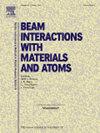Ion irradiation and finite element analysis to assess the effect of swelling on Cr-coated cladding
IF 1.4
3区 物理与天体物理
Q3 INSTRUMENTS & INSTRUMENTATION
Nuclear Instruments & Methods in Physics Research Section B-beam Interactions With Materials and Atoms
Pub Date : 2025-04-19
DOI:10.1016/j.nimb.2025.165702
引用次数: 0
Abstract
By combining ion irradiation and finite element analysis, the effect of irradiation-induced swelling on the structural integrity of nuclear reactor components can be assessed. In this study, ion irradiation is used to obtain the void swelling as a function of damage level in pure chromium (Cr). Cr swells easily and exhibits almost no incubation period for swelling. The experimentally obtained swelling curve is then used as input for finite element analysis to evaluate the interfacial stress buildup in Cr-coated zircaloy tubes at reactor operation temperatures. As one accident-tolerant fuel design currently under evaluation by the nuclear industry, Cr coating can improve the oxidation resistance of zircaloy fuel cladding under abnormal conditions. However, the likelihood of debonding of the Cr coating from Zircaloy tubes needs to be evaluated. The stress evolution, after considering the contributions from thermal expansion, differential void swelling, and creep relaxation, is modeled as a function of time. The study shows that the highest probability of debonding occurs when the fuel cladding cools down when the reactor is shut down for refueling. The methodology presented in this study can be applied to other coating systems to evaluate their tolerance to radiation and accident scenarios.
离子辐照及有限元分析评价膨胀对cr包覆层的影响
将离子辐照与有限元分析相结合,可以评估辐照致膨胀对核反应堆部件结构完整性的影响。在本研究中,离子辐照获得了纯铬(Cr)中空洞膨胀与损伤程度的函数关系。Cr容易肿胀,几乎没有肿胀潜伏期。然后将实验得到的膨胀曲线作为有限元分析的输入,以评估在反应器工作温度下cr涂层锆合金管中的界面应力积累。Cr包覆层可以提高锆合金燃料包壳在异常条件下的抗氧化性能,是目前核工业正在评估的一种耐事故燃料设计。然而,锆合金管的Cr涂层脱粘的可能性需要评估。在考虑了热膨胀、微分空隙膨胀和蠕变松弛的作用后,应力演化作为时间的函数进行建模。研究表明,当反应堆关闭进行换料时,燃料包层冷却时,脱粘的可能性最高。本研究提出的方法可以应用于其他涂层系统,以评估其对辐射和事故情景的耐受性。
本文章由计算机程序翻译,如有差异,请以英文原文为准。
求助全文
约1分钟内获得全文
求助全文
来源期刊
CiteScore
2.80
自引率
7.70%
发文量
231
审稿时长
1.9 months
期刊介绍:
Section B of Nuclear Instruments and Methods in Physics Research covers all aspects of the interaction of energetic beams with atoms, molecules and aggregate forms of matter. This includes ion beam analysis and ion beam modification of materials as well as basic data of importance for these studies. Topics of general interest include: atomic collisions in solids, particle channelling, all aspects of collision cascades, the modification of materials by energetic beams, ion implantation, irradiation - induced changes in materials, the physics and chemistry of beam interactions and the analysis of materials by all forms of energetic radiation. Modification by ion, laser and electron beams for the study of electronic materials, metals, ceramics, insulators, polymers and other important and new materials systems are included. Related studies, such as the application of ion beam analysis to biological, archaeological and geological samples as well as applications to solve problems in planetary science are also welcome. Energetic beams of interest include atomic and molecular ions, neutrons, positrons and muons, plasmas directed at surfaces, electron and photon beams, including laser treated surfaces and studies of solids by photon radiation from rotating anodes, synchrotrons, etc. In addition, the interaction between various forms of radiation and radiation-induced deposition processes are relevant.

 求助内容:
求助内容: 应助结果提醒方式:
应助结果提醒方式:


